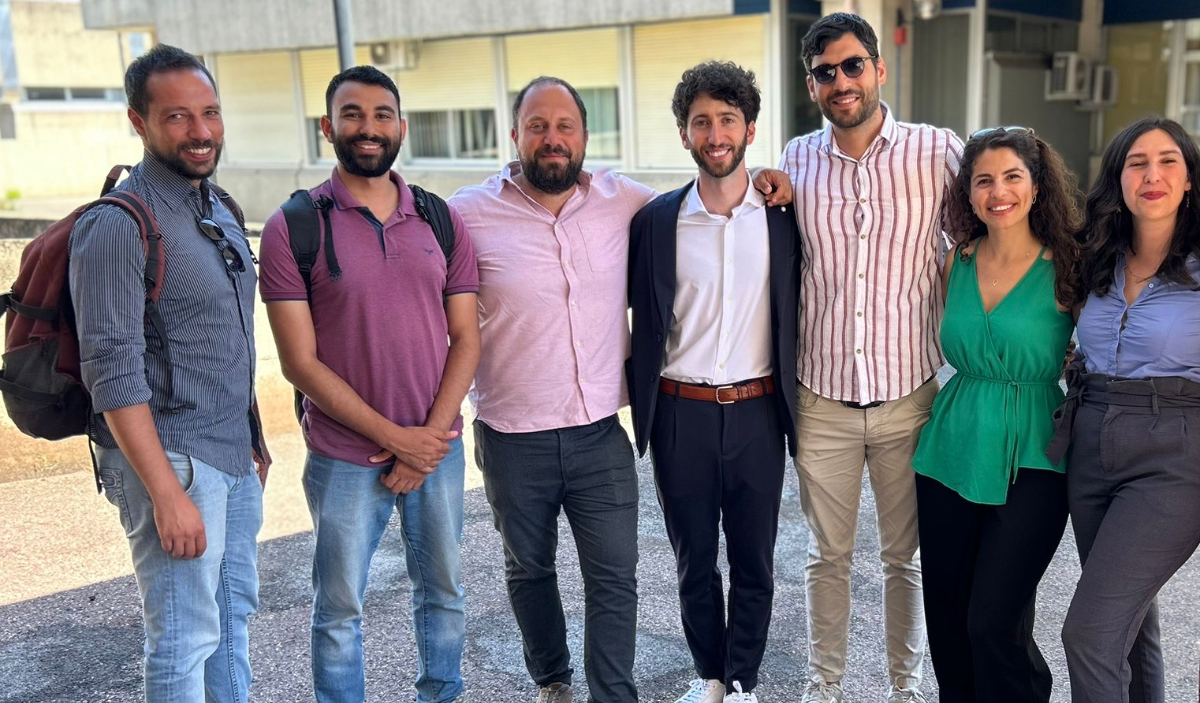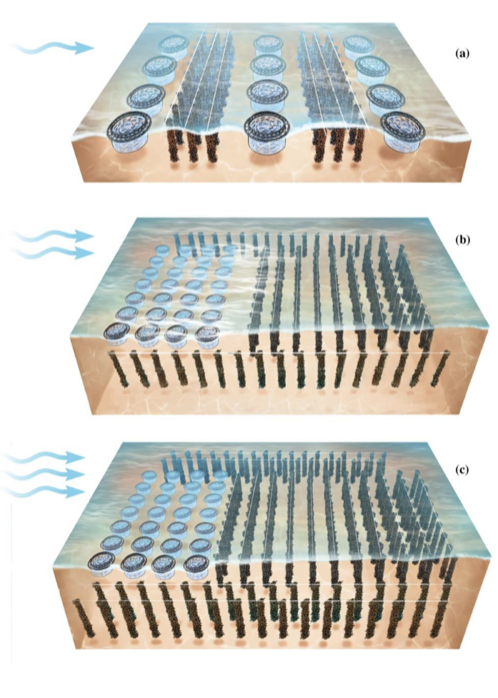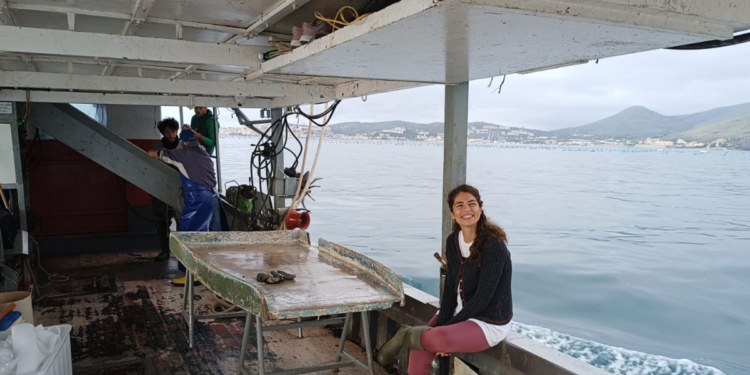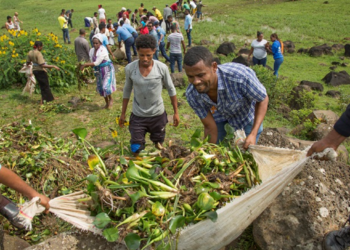Mediterranean mussel (Mytilus galloprovincialis)’s role in Integrated Multi-Trophic Aquaculture (IMTA) – Our research group, based at the Laboratory of Experimental Ecology and Aquaculture of the University of Rome Tor Vergata and led by Dr. Arnold Rakaj, specifically focuses on the potential of marine invertebrates in IMTA. In recent years, we have concentrated on the Mediterranean mussel (Mytilus galloprovincialis), the world’s most widely produced mussel species. While mussels have long been considered extractive species by using the organic and inorganic materials and by-products from the other species for their own growth in IMTA scenarios, recent studies suggest their potential to work synergistically with other extractive species, such as sea cucumbers and macroalgae. This research highlights mussels’ multifaceted role in promoting ecological balance and economic sustainability within marine spatial planning frameworks.
Mussels in IMTA: ecosystem services and environmental benefits
IMTA systems integrate various aquatic species in a way that mimics natural ecosystems, allowing the output from one species to become an input for another. Mussels, as filter feeders, theoretically can feed on both particulate waste coming directly from the fish farming and on phytoplankton which proliferates on dissolved fish waste (mainly nitrogen and phosphate.
In this context, our research question was to what extent mussels rely on each of those food sources with specific focus on IMTA systems and findings showed that mussels positioned in proximity of gilthead seabream farm cages derive their nutrition primarily from phytoplankton. This helps to remediate nutrient load, improves water quality, and minimizes the environmental impact of intensive aquaculture operations. In this way, mussels contribute to nutrient cycling by converting phytoplankton into biomass. This not only mitigates eutrophication but also provides a sustainable source of nutrition for human consumption. By incorporating mussels into IMTA, aquaculture operations can adopt a circular model of resource use, enhancing both productivity and ecological health.

Tailoring mussel farming to site specific conditions
This investigation allowed us to define three site-specific scenarios tailored to local hydrodynamic conditions (current, turbulence, mixing, wave action etc.), mainly considering two important parameters, finfish/mussel biomass and the distance between mussel farming ropes. These models aim to maximize mussels’ extractive potential via phytoplakton while ensuring optimal growth and sustainability:
- Low hydrodynamism regions: Mussels and fish cages should be merged to increase feeding efficiency by allowing mussels to access a concentrated supply of phytoplankton, which thrives in these conditions. Such configurations are suitable for sheltered bays or lagoons where water flow is limited.
- Moderate hydrodynamism regions: Mussels should be placed downstream of finfish farms in regions with moderate water movement. This strategic positioning extends the time mussels have to filter the water carried by the current, enhancing nutrient uptake after phytoplankton growth stimulation by waste. Moderate-flow environments, such as coastal inlets, offer ideal conditions for this model.
- High-hydrodynamism regions: Mussels should be distributed more packed to wider areas to slow the water flow and reduce physical stress in areas with fast-moving currents. This dispersed arrangement enhances feeding opportunities by increasing exposure to passing phytoplankton while minimizing the mechanical strain caused by turbulent waters. Open-sea farms exemplify such environments.

(a) Low Hydrodynamism Regions, Small-size close integration;
(b) Moderate Hydrodynamism Regions, Medium-size downstream integration;
(c) High Hydrodynamism Regions, Large-size downstream integration.
By tailoring mussel placement to hydrodynamic conditions, aquaculture operators can optimize both environmental sustainability and commercial yield, contributing to a more efficient IMTA functioning.
Integrating mussels with other extractive species
Combining mussels with other extractive species, such as sea cucumbers and macroalgae, is a promising avenue for regenerative aquaculture. This multi-species approach not only diversifies production but also enhances ecosystem services. For instance, sea cucumbers contribute to sediment remediation by consuming organic detritus, while macroalgae absorb dissolved nutrients and carbon dioxide, offering additional environmental benefits.
In practical applications, the most effective IMTA pairings currently involve finfish with mussels or mussels with macroalgae and sea cucumbers. These combinations provide a holistic solution to nutrient management, reducing the environmental footprint of aquaculture operations. Furthermore, they enhance waste mitigation and economic opportunities by diversifying product offerings and creating new markets for high-value, sustainably produced seafood.
The European Context: Challenges and Opportunities
While IMTA systems in Asia are well-established, Europe is still in the early stages of adopting these practices. China has achieved significant success, whereby 40% of its mariculture production comes from IMTA systems. Strong government support, adaptive policies, and nationwide promotion of IMTA across marine environments are key drivers of this success. Other critical factors include endemic extractive species knowledge, labor costs reduction, high consumer demand, and the need to reduce land use to feed a large population.
IMTA adoption in Europe lags behind Asia due to economic, regulatory, and cultural barriers. Higher wages and production costs make the transition less viable, while strict environmental and food safety regulations add further challenges. Unlike Asia’s centralized and flexible regulatory support for large-scale IMTA and extensive experience with extractive species like seaweeds, shellfish, and sea cucumbers, Europe’s aquaculture sector is dominated by monoculture, with limited experience in cultivating extractive species. Consumer preferences for high-trophic species and intense competition for marine space also slow IMTA’s expansion. However, Europe’s stringent regulations ensure safe, high-value seafood, which should be maintained. To advance IMTA, Europe can focus on marine zoning through Allocated Zones for Aquaculture (AZA), similar to Asia’s designated mariculture zones, while fostering knowledge exchange and capacity building between regions.
Investing in research and development is crucial for reaching the full potential of mussel-based IMTA. Key areas for future investigation include:
- Species compatibility: Identifying optimal species combinations tailored to European marine environments.
-
Farm design optimization: Developing efficient farm layouts that maximize nutrient capture and resource use.
Economic viability: Assessing the financial sustainability of IMTA models and identifying pathways for market integration. -
Waste-to-value ınnovations: Exploring methods to transform organic byproducts into valuable commodities, such as food and feed, biofuels or nutraceuticals.
Knowledge transfer: Implementing specialized training programs to equip aquaculture practitioners with the skills needed to adopt IMTA technologies.
By addressing these research gaps, Europe can accelerate the adoption of IMTA, fostering a sustainable blue economy that balances ecological health with commercial interests.
In conclusion, mussels are poised to play a transformative role in the future of aquaculture. Their ability to improve water quality, support biodiversity, and contribute to economic resilience makes them invaluable assets within IMTA systems. By embracing IMTA, we can move toward a future where marine resources are managed sustainably, ensuring the health of our oceans and the prosperity of coastal communities for generations to come.
Scientific source: Batır, E., Aydın, İ., Theodorou, J. A., & Rakaj, A. (2025). Mytilus galloprovincialis’s role in Integrated Multi‐Trophic Aquaculture (IMTA): A comprehensive review. Journal of the World Aquaculture Society, 56(2), e70013. https://doi.org/10.1111/jwas.70013
Mediterranean mussel (Mytilus galloprovincialis)’s role in Integrated Multi-Trophic Aquaculture (IMTA)









